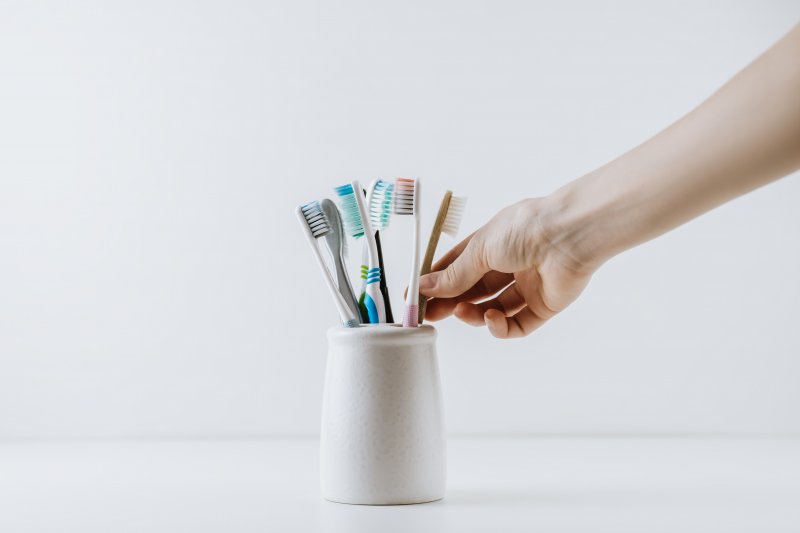
Seeing so many different types of toothbrushes at your local drug store can be overwhelming. They come in a variety of shapes, sizes, and price ranges. It is often difficult to decide which one could benefit you the most without breaking the bank. Continue reading to learn more from your dentist in Newark about choosing the best toothbrush for your individual smile.
Manual Toothbrushes
This type of toothbrush is generally more affordable than its electric counterpart and requires you to do all of the work. However, if you have a good brushing technique, manual style toothbrushes are perfectly sufficient for keeping your smile clean. If you are choosing this type of brush, there are a few things you should consider:
Bristle Hardness
- Soft: Dentists recommend that most patients use a soft-bristled toothbrush on a regular basis. With good technique, it is effective at cleaning away plaque and food debris without causing damage to your gums or enamel.
- Medium: If you have average oral health conditions, a medium-bristled toothbrush is also a good option. They remove plaque and debris just as well as soft toothbrushes, but they can damage your gum tissue if you use them incorrectly.
- Hard: It is difficult to come across hard-bristled toothbrushes anymore. Even though they are great at removing plaque and debris, they can easily wear away your tooth enamel and cause gum recession.
Head Design
There are two main head shapes for manual toothbrushes:
- Diamond: When heads come in this shape, it is easier to reach areas in the back of the mouth.
- Conventional: This is a larger head, but this makes it more difficult to clean hard to reach areas, especially around your molars.
Bristle Design
There are several different bristle designs, each having their own advantages:
- Wavy: This type is effective at reaching adjacent tooth surfaces.
- Criss-Cross: These are best at removing plaque from the teeth.
- Polishing Cup: This design is great at removing surface stains.
- Tapered: When it comes to reaching hidden sections of the teeth, this is the way to go.
Electric Toothbrushes
Many people prefer the use of electric toothbrushes because they offer a greater level of convenience to the user. Here are the most common types of electric toothbrushes:
- Duel Head: This one has two heads on one handle. One of the heads rotates to remove plaque, while the other cleans away dirt.
- Side to Side: As advertised, these bristles move side to side instead of rotating.
- Counter-Oscillating: The bristles rotate in different directions in order to dislodge plaque and food debris.
- Sonic: This type of brush vibrates at a high speed making them more effective at dislodging both plaque and tartar.
What Other Options Are Out There?
- Sulcabrush: If you have periodontal disease, your dentist may recommend this brush. It is made of a single tuft which is used vertically. It helps to reduce bleeding and slow down the progression of gum disease.
- Interdental Brush: For patients who have braces, this brush is a handy tool. It complements your normal brushing routine by reaching places that are inaccessible, like around brackets and behind wires.
To ensure that you are best taking care of your smile, it’s important to choose the tools that can benefit you the best. Next time you invest in a new toothbrush, keep all of the varieties in mind!
About the Practice
Dr. Donald T. Bond and Dr. Timothy D. Ganfield are well experienced dentists serving patients at White Clay Dental Associates in Newark, DE. Dr. Bond earned his Doctor of Dental Surgery at the Virginia Commonwealth University School of Dentistry. Dr. Ganfield earned his doctorate at Temple University, where he graduated Magna Cum Laude. They are both members of multiple organizations including the American Dental Association and Delaware State Dental Society. For more information on proper dental hygiene or to schedule an appointment, visit their website or call (302) 731-4225.
